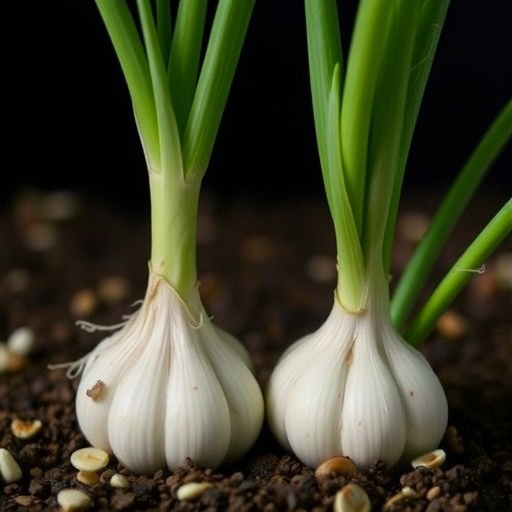Endophytic Microbes in Garlic Enhance Plant Growth – Bioengineer.org

Report on the Role of Endophytic Microbiota in Sustainable Agriculture
A Study on Plant Growth-Promoting Endophytes from Garlic Bulbs
Executive Summary
A recent study by Quezada-García et al. investigates the endophytic microbiota within garlic bulbs, revealing significant potential for advancing sustainable agricultural practices. The research identifies beneficial microorganisms that enhance plant growth, improve resilience to environmental stressors, and offer natural alternatives to chemical inputs. These findings have direct implications for achieving several United Nations Sustainable Development Goals (SDGs), particularly SDG 2 (Zero Hunger), SDG 12 (Responsible Consumption and Production), SDG 13 (Climate Action), and SDG 15 (Life on Land).
Introduction: Aligning Agricultural Innovation with Sustainable Development Goals
In the face of a growing global population, climate change, and soil degradation, innovative solutions are required to ensure food security and environmental sustainability. This report examines research on the symbiotic relationship between garlic plants and their internal microbial communities (endophytes). The study provides a microbial-based approach to enhance crop production, directly supporting the framework of the Sustainable Development Goals by promoting resilient and eco-friendly agricultural systems.
Key Research Findings and Contributions to SDGs
Enhancing Food Security and Sustainable Agriculture (SDG 2 & SDG 12)
The study demonstrates that endophytic bacteria can significantly boost plant productivity, a key target of SDG 2. This is achieved through several mechanisms that promote responsible and sustainable production methods, aligning with SDG 12.
- Phytohormone Production: Certain endophytic bacteria produce auxins, which are critical plant hormones that stimulate root elongation and lateral root development. This enhances the plant’s ability to absorb water and nutrients, leading to improved vigor and yield.
- Nutrient Solubilization: The microbiota aids in making essential nutrients in the soil more available to the plant, reducing the need for synthetic fertilizers.
- Biocontrol Properties: Many identified endophytes exhibit biocontrol capabilities, inhibiting the growth of plant pathogens. This provides a natural alternative to chemical pesticides, reducing chemical runoff and promoting safer food production.
Building Climate Resilience in Agriculture (SDG 13)
The research highlights the role of endophytes in strengthening plant resilience against abiotic stressors, a critical component of climate action (SDG 13) for the agricultural sector.
- Drought and Salinity Tolerance: The presence of specific bacterial strains was found to bolster the garlic plant’s ability to withstand adverse environmental conditions such as drought and high salinity.
- Adaptation to Climate Change: By enhancing the innate resilience of crops, these microbial partners help secure agricultural yields against the unpredictable weather patterns associated with climate change.
Promoting Ecosystem Health and Biodiversity (SDG 15)
The findings underscore the foundational role of microbial diversity in terrestrial ecosystems, a core principle of SDG 15.
- Soil Health: The study reinforces that healthy soils with diverse microbial life are essential for sustainable agriculture. Harnessing endophytes contributes to regenerating soil fertility and function.
- Reduced Chemical Dependence: By offering a biological method for pest control and growth promotion, this research paves the way for reducing agriculture’s reliance on synthetic chemicals that can harm ecosystems.
- Biodiversity Preservation: The research illustrates the interconnectedness of plant and microbial life, emphasizing that the preservation of plant biodiversity is crucial for maintaining a robust and beneficial microbiome for agriculture.
Methodological Approach
The research team employed advanced scientific techniques to achieve its findings. The process involved:
- Meticulous isolation and characterization of endophytic bacteria from garlic bulbs.
- Identification of species with plant growth-promoting characteristics.
- Advanced genomic sequencing to create a comprehensive map of the microbial diversity within the plant tissues.
Policy and Practice Implications for Sustainable Development
The outcomes of this research present a clear blueprint for integrating microbial solutions into agricultural policy and practice to advance the SDGs.
- Integration into Farming: Farmers can adopt cultivation strategies that incorporate beneficial microbes to enhance crop productivity while minimizing environmental impact.
- Policy Support: Policymakers should support the development and application of microbial-based biofertilizers and biocontrol agents as part of a broader strategy for sustainable agriculture.
- Investment in Research: Continued investment in microbial research is necessary to unlock the full potential of plant-microbe interactions for global food security and ecosystem health.
Conclusion: A Pathway to Sustainable Agricultural Futures
The study on garlic bulb endophytes provides compelling evidence that harnessing natural plant-microbe partnerships is a viable and powerful strategy for creating a more sustainable and productive agricultural future. By integrating these findings into practice, the agricultural sector can make significant strides toward achieving key Sustainable Development Goals, fostering a harmonious balance between food production and environmental stewardship.
Analysis of Sustainable Development Goals in the Article
1. Which SDGs are addressed or connected to the issues highlighted in the article?
-
SDG 2: Zero Hunger
- The article focuses on enhancing plant growth, yield, and overall crop production through the use of endophytic microbiota. This directly addresses the challenge of ensuring food security for a rising global population by promoting innovative and sustainable agricultural practices.
-
SDG 12: Responsible Consumption and Production
- The research promotes sustainable and eco-friendly agricultural practices. By highlighting the potential of endophytic bacteria as a “natural alternative to chemical pesticides,” the article aligns with the goal of reducing chemical use and promoting environmentally sound production methods.
-
SDG 13: Climate Action
- The article explicitly mentions that endophytes can enhance a plant’s resilience to abiotic stressors like “drought and salinity,” which are exacerbated by climate change. This contributes to strengthening the adaptive capacity of agricultural systems to climate-related hazards.
-
SDG 15: Life on Land
- The research underscores the importance of healthy soils and biodiversity. It discusses combating “soil degradation and declining fertility” by leveraging microbial life and emphasizes that “preserving plant biodiversity” is crucial for maintaining a robust microbiome, which in turn supports agricultural ecosystems.
2. What specific targets under those SDGs can be identified based on the article’s content?
-
Target 2.4 (under SDG 2)
- This target aims to ensure sustainable food production systems and implement resilient agricultural practices that increase productivity and help maintain ecosystems. The article’s focus on using endophytes to enhance “yield,” improve “plant vigor,” and create “sustainable farming practices” that are resilient to environmental stress directly supports this target.
-
Target 12.4 (under SDG 12)
- This target calls for the environmentally sound management of chemicals to minimize their adverse impacts. The article’s suggestion of using endophytic bacteria for “biocontrol of plant pathogens” serves as a “natural alternative to chemical pesticides,” contributing to the reduction of chemical release into the environment.
-
Target 13.1 (under SDG 13)
- This target focuses on strengthening resilience and adaptive capacity to climate-related hazards. The article highlights that endophytes bolster a plant’s ability to withstand “drought and salinity” and improve “resilience… in the face of climate change,” which directly aligns with building adaptive capacity in agriculture.
-
Target 15.3 (under SDG 15)
- This target aims to combat desertification and restore degraded land and soil. The article addresses the challenge of “soil degradation and declining fertility” by proposing that fostering “diverse microbial life” is foundational to improving “soil health” and achieving sustainable agriculture.
3. Are there any indicators mentioned or implied in the article that can be used to measure progress towards the identified targets?
-
Agricultural Productivity and Yield (Implied)
- The article repeatedly mentions enhancing “plant health, growth, and yield.” An increase in crop yield per hectare would be a direct indicator of progress towards Target 2.4.
-
Reduction in Chemical Pesticide Use (Implied)
- The promotion of endophytes for “biocontrol properties” as an “organic approach to pest management” implies that a key indicator would be the reduced volume of chemical pesticides applied in agriculture, which relates to Target 12.4.
-
Crop Resilience to Environmental Stressors (Implied)
- The article’s emphasis on bolstering a plant’s ability to withstand “drought and salinity” suggests that an indicator for Target 13.1 would be the stability of crop yields in regions affected by these climate-related stressors.
-
Soil Health and Microbial Diversity (Implied)
- The discussion on “healthy soils, teeming with diverse microbial life” and the use of genomic techniques to create a “comprehensive map of the microbial diversity” points to soil organic matter content and microbial biodiversity as key indicators for measuring progress in combating soil degradation under Target 15.3.
4. Summary Table of SDGs, Targets, and Indicators
| SDGs | Targets | Indicators (Implied from the Article) |
|---|---|---|
| SDG 2: Zero Hunger | Target 2.4: Ensure sustainable food production systems and implement resilient agricultural practices that increase productivity. | Increase in agricultural yield and crop productivity. |
| SDG 12: Responsible Consumption and Production | Target 12.4: Achieve the environmentally sound management of chemicals and reduce their release to minimize adverse impacts. | Reduction in the use of chemical pesticides through biocontrol alternatives. |
| SDG 13: Climate Action | Target 13.1: Strengthen resilience and adaptive capacity to climate-related hazards. | Enhanced crop resilience and stability of yields under abiotic stressors like drought and salinity. |
| SDG 15: Life on Land | Target 15.3: Combat desertification, restore degraded land and soil. | Improvement in soil health metrics and increased microbial diversity in agricultural soils. |
Source: bioengineer.org
What is Your Reaction?
 Like
0
Like
0
 Dislike
0
Dislike
0
 Love
0
Love
0
 Funny
0
Funny
0
 Angry
0
Angry
0
 Sad
0
Sad
0
 Wow
0
Wow
0
















































/environment-climate-change-and-health-(ech)/water-sanitation-hygiene-and-health-(wsh)/landfill-tuvalu-36092.tmb-1200v.jpg?sfvrsn=5c21fe40_1#)

.jpg.webp?itok=0ZsAnae9#)

























